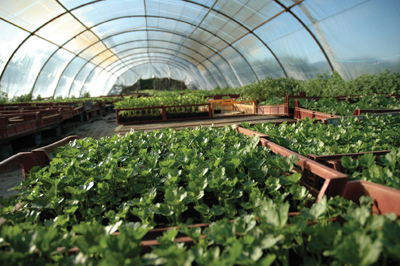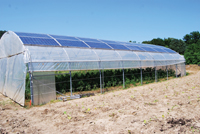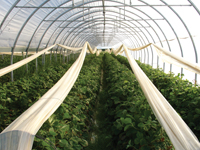
Not all high tunnels are the same, according to Adam Montri, tunnel crop researcher with Michigan State University (MSU).
Not all high tunnels are the same, according to Adam Montri, tunnel crop researcher with Michigan State University (MSU).
 |
| During the winter months, Adam Montri, a tunnel crop researcher with Michigan State University (MSU), grows a salad mix crop of leaf lettuce, arugula and others in his hoop house, which is similar to this one. Advertisement
|
When people think of tunnels they tend to think of the three-season ground-to-ground hoop structure but there is also the gothic-style frame, the hoop roof with straight wall, and the Quonset or hoop-house style that appears to be the most popular.
There are also high tunnels that can be used during the winter. “Yes, it’s possible to grow crops without supplemental heat and light during all four seasons,” Montri said during a recent presentation at the Ontario Fruit & Vegetable Conference held in St. Catharines, Ont.

|
| Adam Montri, a tunnel crop researcher with Michigan State University (MSU) |
Comparing the structures, Montri said the three-season tunnel is generally multi-bay, and is well suited for starting plants early in the spring and is popular among organic growers. It is also good for hot and cold temperature fluctuations when trying to induce dormancy in crops such as strawberries or raspberries, which the four-season tunnel does not do well, said Montri.
The three-season tunnel is constructed of rafters made of lighter steel that are spaced wider apart than the four-season one. The plastic sheeting may also be thinner and needs to be rolled back in the fall because its load bearing capacity for snow is poor.
A four-season tunnel, also known as a hoop house, is usually one bay wide with heavier gauge metal rafters that are covered with six-mil plastic sheeting. A double layer of plastic can also be used. To keep the structure tight, the tunnel ends are wood framed with a walk-in door. The end vents can be manually operated or electric fans can be installed. In the heat of the summer, the sides can be rolled up for added ventilation.
In both styles of structure, sunlight passes through the plastic and warms the soil during the day. This heat is then released at night. “Some people like to use barrels of water to amplify this same effect but it takes valuable space out of production,” Montri said. “And the ground rarely freezes in a four-season tunnel.”
Besides being a researcher of crops grown in tunnels, Montri also has a four-season high tunnel on the family farm near Bath, Mich. His hoop house is a single bay and measures 34 by 96 feet.
Montri’s first crop of the spring is tomatoes, which he likes to have planted by April 15 and in full harvest by the end of June. His earliest harvest start date so far has been June 4.
“The Fourth of July marks the holiday season for us and everyone has their barbeques going. Most people are quite happy to pay $5 a pound so they’ll have fresh, sliced tomatoes to put on their burgers,” he said.
Montri said there are other early season crops to consider, such as squash, basil, carrots and peppers.
 |
| In the heat of the summer, the sides of the hoop house can be rolled up for added ventilation.
|
Flowers are another popular early season crop and some favourites include sunflower, snapdragon, and lisianthus, which produces a rose-like flower that is easy to grow and fast becoming popular. “There’s also a premium paid for flowers with a 30-inch stem,” he said.
To maximize space, Montri uses trellises for tomatoes and raspberries and sows the vegetable crops between the trellis rows. He said the seed can be planted tightly together. With carrots, for example, he jams in 12 rows per bed, whereas in field cultivation, it would be three rows.
He also mentioned that raspberries do quite well in a high tunnel. “With them, you should expect a 97 per cent marketable yield. They have few botrytis problems.”
During the winter months, Montri grows a salad mix crop of leaf lettuce, arugula and others in his hoop house, which he keeps protected under a suspended row cover of breathable Agribon AG-19. Plastic row covers can also be used. Wire hoops placed over the rows also work well at keep the cover off the plants while still trapping the heat and moisture at the crop level.
Montri and his wife spend about 10 hours per week during the winter months harvesting their salad mix. The leafy greens are bundled in five to six ounce packages and sold for $5 per bag, or $20 per pound. One ounce is generally enough for one person’s salad, he explained. “There haven’t been any complaints, and it’s better and fresher than the mix being shipped from California.”
 |
| Wire hoops placed over the crop rows planted in the hoop house work well at keeping the cover off the plants while still trapping the heat and moisture at the crop level.
|
Other good winter crops include spinach and leek plus herbs such as parsley and basil, and fresh cilantro is always popular among those who make salsa. Montri said that all root crops do well, including carrot, radish, onion and turnip.
All of the produce Montri grows is sold locally through Michigan’s Community Supported Agriculture (CSA) program. They have a small group of customers who pay for their produce up front, and pick up their box of fresh produce every Wednesday. This summer, the couple plans to sell their fruit and vegetables at the local farmer’s market.
During the warm seasons, Montri uses drip irrigation on all of his crops. In the winter, he relies on a water line buried at 42 inches, and frost-free hydrants in the hoop house that he uses for hand watering with a garden hose and nozzle.
“We build up the soil moisture in the fall so there isn’t a deficit in the winter, plus the row cover helps keep it maintained,’ he explained. “From November to February 1, we only water about three times, and it’s generally a spot spray on the dry spots.” Montri cautioned that it is important to not get the soil too wet because mould will develop at 50 Fahrenheit.
Print this page